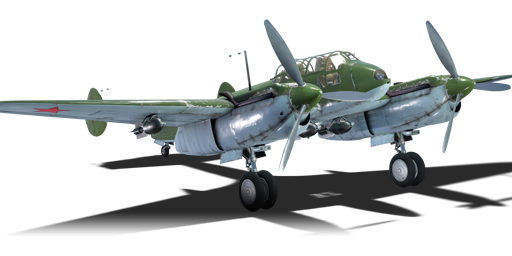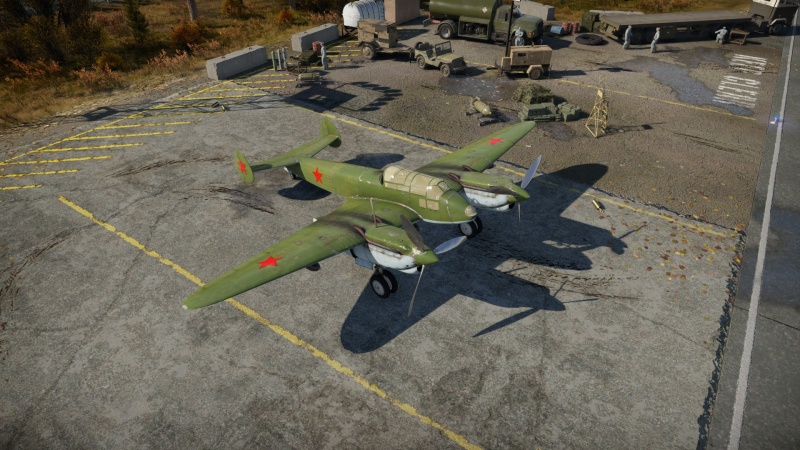Difference between revisions of "Yak-4"
m (→External links) |
m (→Details) |
||
| Line 56: | Line 56: | ||
! Combat !! Take-off !! Landing !! + !! - | ! Combat !! Take-off !! Landing !! + !! - | ||
|- | |- | ||
| − | | {{Specs|destruction|body}} || {{Specs|destruction|gear}} || N/A || N/A || 280 || ~ | + | | {{Specs|destruction|body}} || {{Specs|destruction|gear}} || N/A || N/A || 280 || ~15 || ~7 |
|- | |- | ||
|} | |} | ||
Revision as of 10:38, 18 February 2021
Contents
Description
The Yak-4 is a rank I Soviet bomber with a battle rating of 2.0 (AB/RB) and 2.3 (SB). It was introduced in Update 1.75 "La Résistance".
General info
Flight performance
The Yak-4 has relatively unsurprising flight characteristics given its size and rank. It has a lacklustre climb rate and acceleration, and as with most Soviet-engined aircraft, it suffocates above 4,000 metres in altitude. Thus, the aircraft should stay at lower altitudes, as the engines will drastically lose thrust above the 4,000-metre threshold. As well, the engines will overheat rapidly when applying WEP, so it is advised to keep the engine throttles at 100%.
The Yak-4 isn't that manoeuvrable, though it can outfly larger twin-engine bombers such as the Wellington or He 111. Its control surfaces are rather stiff, and thus the aircraft doesn't roll or turn particularly quickly. Top speed is also rather mediocre, reaching ~450 km/h when flying at lower altitudes. Though the aircraft has decent dive performance, keep in mind that the aircraft's wings will break off at 680 km/h.
| Characteristics | Max Speed (km/h at 4,800 m) |
Max altitude (metres) |
Turn time (seconds) |
Rate of climb (metres/second) |
Take-off run (metres) | |||
|---|---|---|---|---|---|---|---|---|
| AB | RB | AB | RB | AB | RB | |||
| Stock | 513 | 496 | 10800 | 25.1 | 26.1 | 7.8 | 7.8 | 550 |
| Upgraded | 555 | 533 | 22.9 | 24.0 | 13.4 | 10.4 | ||
Details
| Features | ||||
|---|---|---|---|---|
| Combat flaps | Take-off flaps | Landing flaps | Air brakes | Arrestor gear |
| X | X | ✓ | X | X |
| Limits | ||||||
|---|---|---|---|---|---|---|
| Wings (km/h) | Gear (km/h) | Flaps (km/h) | Max Static G | |||
| Combat | Take-off | Landing | + | - | ||
| 0 | 320 | N/A | N/A | 280 | ~15 | ~7 |
| Optimal velocities (km/h) | |||
|---|---|---|---|
| Ailerons | Rudder | Elevators | Radiator |
| < 360 | < 360 | < 450 | > 340 |
| Compressor (RB/SB) | ||
|---|---|---|
| Setting 1 | ||
| Optimal altitude | 100% Engine power | WEP Engine power |
| 2,000 m | 1,100 hp | 1,186 hp |
| Setting 2 | ||
| Optimal altitude | 100% Engine power | WEP Engine power |
| 4,000 m | 1,050 hp | N/A |
Survivability and armour
- 8 mm Steel plate in the pilot's seat
- 8 mm Steel plate under the pilot
- Self-sealing fuel tanks (2 in each wing)
Modifications and economy
Armaments
Offensive armament
The Yak-4 is armed with:
- 1 x 7.62 mm ShKAS machine gun, nose-mounted (500 rpg)
Suspended armament
The Yak-4 can be outfitted with the following ordnance:
- 8 x 100 kg FAB-100sv bombs (800 kg total)
Defensive armament
The Yak-4 is defended by:
- 1 x 7.62 mm ShKAS machine gun, dorsal turret (1,000 rpg)
Usage in battles
The Yak-4 can be used primarily as a ground attack aircraft, as its small bomb load prevents it from being an effective bomber. Pilots can utilize the aircraft's airspawn and 100 kg bomb load to destroy softer targets, then return to base to rearm. The aircraft is fitted with a single frontal 7.62 mm ShKAS machine gun and a similar weapon at the rear of the cockpit; though effective, these machine guns are no match for the armament typically carried on fighters the Yak-4 will face in battle. Thus, avoid getting into any dogfights, and if being chased, use the dorsal turret to light up any pursuing aircraft.
At the start of the battle, locate and fly towards any targets located at the sides of the map, as you are less likely to be intercepted and attacked by any approaching fighters. The 100 kg bombs can be used to destroy any harder targets (like light pillboxes or light tanks), while the ShKAS can be used against softer targets such as anti-aircraft guns and vehicles. Keep in mind that the Yak-4 has access to a bomb sight - this can make precision bombing a much easier task. However, it may be more effective to use the 100 kg bombs against "light" targets, as medium tanks and pillboxes will require direct hits to destroy.
If you see an enemy fighter approaching, the best strategy is to simply run towards your own side and request fighter cover. This is because the Yak-4 is completely uncompetitive against the fighters it usually faces, including Spitfires, Hurricanes, and Bf 109s. You're less agile than them, and also have a slower speed. If there is no option at all, simply fly away from the pursuing fighter - force them to come in from behind, where your ShKAS is able to fire at them. Though the ShKAS is only of 7.62 mm calibre, it can still do significant damage and potentially set an engine on fire, if used right. Though it may be tempting to head-on, don't do it - you have no frontal armour and a significantly weaker frontal armament, which is the perfect recipe for a quick pilot-snipe.
Manual Engine Control
| MEC elements | ||||||
|---|---|---|---|---|---|---|
| Mixer | Pitch | Radiator | Supercharger | Turbocharger | ||
| Oil | Water | Type | ||||
| Controllable | Controllable Not auto controlled |
Controllable Not auto controlled |
Controllable Not auto controlled |
Separate | Controllable 2 gears |
Not controllable |
Pros and cons
Pros:
- Excellent speed
- Good climb rate
- Decent manoeuvrability for a bomber
- Possesses offensive armament, one centrally mounted ShKAS (7.62 mm) gun, coupling great accuracy with a superb rate of fire
Cons:
- Very poor bomb load, will struggle at taking out armoured targets (medium tanks, pillboxes, etc.), ineffective at base bombing
- Bleeds speed in turns
- Vulnerable engines tend to overheat quickly at 100% throttle
- Rear gunner cannot aim below 0°, rendering you harmless to any enemies under the plane
- Similar to the Yak-2, pilot has no frontal protection and can be knocked out easily
History
The Yakovlev Yak-4 was a light bomber developed from the Yak-2 light bomber (not to be confused with the Yak-2 KABB attacker), the result of a series of improvements implemented to rectify the issues of its predecessor, which included inadequate speed, an unsatisfactory cooling system, and a weak/troublesome undercarriage. To increase speed, the drag of engine doors and cowlings was reduced, the fuselage upper decking was cut down, and the aircraft was refitted with Klimov M-105 engines. Such improvements increased the speed by 10-20km/h. To reduce overheating, the oil coolers were relocated to the chin of the engine compartments. To fix problems with the undercarriage, the single wheeled landing gear was replaced with a double wheeled one. The Yak-4 first flew on February 20, 1940, was put into service in 1941, and had its production terminated that same year. A majority of the aircraft were sent to the 316th Reconnaissance Regiment in the Kiev Military District. Although officially retired in 1945, it is not believed that their usage extended much past Operation Barbarossa as the German forces destroyed most of them in its opening days, in large part due to the inexperience of soviet aircrews. However, a few remaining Yak-4s may have found use later in the war as glider tugs or suppliers. A total of around 90 were produced.
Media
Excellent additions to the article would be video guides, screenshots from the game, and photos.
See also
Links to the articles on the War Thunder Wiki that you think will be useful for the reader, for example:
- reference to the series of the aircraft;
- links to approximate analogues of other nations and research trees.
External links
| A.S. Yakovlev Design Bureau (Яковлев Опытное конструкторское бюро) | |
|---|---|
| Fighters | |
| Yak-1 | Yak-1 · Yak-1B |
| Yak-3 | Yak-3 · Eremin's Yak-3(e) · Yak-3 (VK-107) · Yak-3P · Yak-3T · Yak-3U |
| Yak-7 | Yak-7B |
| Yak-9 | Yak-9 · Yak-9B · Yak-9K · Golovachev's Yak-9M · Yak-9P · Yak-9T · Yak-9U · Yak-9UT |
| Twin-engine fighters | I-29 |
| Jet fighters | |
| Yak-15 | Yak-15P · Yak-15 |
| Yak-17 | Yak-17 |
| Yak-23 | Yak-23 |
| Yak-30 | Yak-30D |
| Yak-141 | Yak-141 |
| Strike aircraft | |
| Yak-2 | Yak-2 KABB |
| Yak-38 | Yak-38 · Yak-38M |
| Bombers | Yak-4 |
| Jet bombers | Yak-28B |
| Foreign use | ▄Yak-3 · Challe's ▄Yak-9T · ◔Yak-9P |
| Captured | ▀Yak-1B |
| USSR bombers | |
|---|---|
| SB and Ar | SB 2M-100 · SB 2M-103 · SB 2M-103 MV-3 · SB 2M-103U · SB 2M-103U MV-3 · SB 2M-105 · Ar-2 |
| Yer-2 (petrol) | Yer-2 (M-105) · Yer-2 (M-105) TAT · Yer-2 (M-105R) TAT · Yer-2 (M-105R) LU |
| Yer-2 (diesel) | Yer-2 (ACh-30B) (e) · Yer-2 (ACh-30B) (l) |
| Tu | Tu-2 · Tu-2S · Tu-2S-44 · Tu-2S-59 · Tu-4 |
| Pe | Pe-2-1 · Pe-2-31 · Pe-2-83 · Pe-2-110 · Pe-2-205 · Pe-2-359 · Pe-8 |
| IL | DB-3B · IL-4 |
| Po | Po-2 · Po-2M |
| Other | MBR-2-M-34 · TB-3M-17-32 · Yak-4 · Be-6 |
| Lend-Lease | ▂PBY-5A Catalina · ▂Hampden TB Mk I · ▂A-20G-30 · ▂B-25J-30 |





